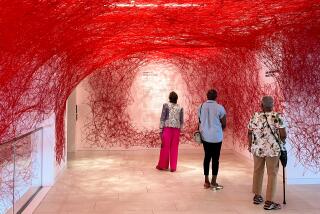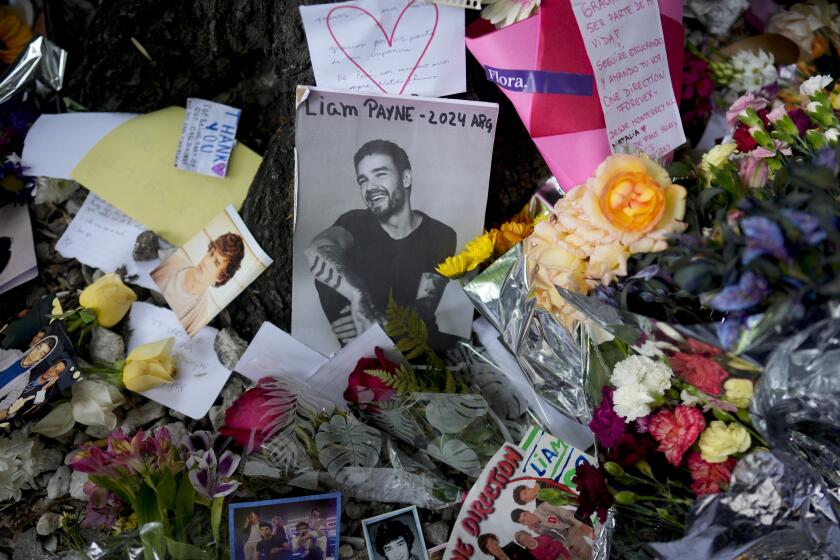Critic’s Notebook: Jeffrey Deitch should expand MOCA’s hours, make admission free
For years, officials at the Museum of Contemporary Art have fretted over attendance. Despite a program that’s arguably the nation’s best, attendance in 2008 stood at 213,549. L.A. County’s population nears 10 million.
The following year, after MOCA’s fiscal mismanagement went public and the museum nearly collapsed, leading to reduced programs, visitor numbers dropped to 148,616. At MOCA’s three venues, that’s fewer than 600 people per day.
When Jeffrey Deitch takes the helm Tuesday as MOCA’s fourth director in 30 years, he’ll face the problem. If I were him, I’d do two things fast: Change the museum’s operating hours and drop the general admission price, from $10 to zero.
Fixing hours and admission could alleviate attendance woes. Both moves require study and planning, but they would begin the long-term process of rebuilding public confidence. And the alternative — a dumbed-down program with flashier, crowd-friendly shows — is too grim to contemplate.
Let’s start with general admission. It might seem counterintuitive to dump ticket fees, especially because MOCA needs money. But two sound reasons argue for it.
One is philosophical. Art is to a museum what books are to a library: Free entry positions the museum as a public service, not a commercial transaction. Then museum membership can be built around a drive to keep admission free for all. Members bring funds and become stakeholders — philanthropy by the regular guy, not just by the rich.
The other reason is practical. Ticket income rarely covers more than just a fraction of museum costs. For the fiscal year ending June 2008, as the nation’s economic crisis unfolded, MOCA’s admission revenues covered less than 3.5% of the annual operating budget.
That small proportion is not unusual in the not-for-profit field. For such an insignificant return, why keep people out — especially from a museum of contemporary art, which many can find daunting?
Gary Vikan, director of Baltimore’s Walters Art Museum, which successfully eliminated admission fees in 2006 in tandem with the Baltimore Museum of Art across town, told me his museum’s income-to-operating numbers had been roughly the same as MOCA’s. He regards zeroing out admissions a huge success, and it’s hard to disagree.
The Walters’ attendance increased almost 40% in the first six months. Half were first-time visitors. (The Walters is a general art museum.) The initial jump has held steady for nearly four years. Notably, in a city with an African American majority population, nonwhite attendance has tripled.
And what about the current economic crisis, when museums have seen their endowments battered? The Walters’ income loss was made up from a combination of public funds, private philanthropy and increased memberships from newly engaged locals. Museum income fluctuations of 3% to 4% are so common as to be insignificant; it makes sense to seize control of the one fluctuation tied to visitors, because they matter most.
“A board member said to me that it’s important to be free in good times,” Vikan added, “but even more important to be free in bad times.”
A changed philosophy has clearly taken hold. And the Baltimore Museum of Art reports similar successes.
Lots of art museums already do have free general admission. Federal museums such as the National Gallery and the Hirshhorn do. Ditto many from the early 20th century, our first big wave of museum building in cities including St. Louis; Toledo, Ohio; and Minneapolis; plus the even older Cincinnati Art Museum and New York’s Metropolitan Museum of Art. (At the Met, admission fees are voluntary.) Baltimore reinstated a free policy that, during the privatizing years of the Reagan era, had been jettisoned for charging fees.
More than a generation ago, before Proposition 13 pulled the rug out from under much of California’s public sector, even a latecomer like the Los Angeles County Museum of Art was free. I was generally no fan of Andrea Rich’s 10-year tenure as LACMA director (1995-2005), but two early initiatives were spot-on. Rich secured underwriting for Met-style voluntary admissions in the evening. And she changed museum hours, making those evenings possible: LACMA is now open daily (except Wednesdays) until 8 or 9 p.m.
MOCA is open daily (except Tuesdays and Wednesdays) until 5 or 6 p.m. and only on Thursdays until 8. If you work or are in school, the place is off-limits much of the time.
If you work downtown, you can skip lunch to go or come back on the weekend, which isn’t likely. Stopping in after work, then maybe going out to dinner, mostly cannot happen.
The city has 40,000-plus downtown residents. A 2008 demographic study shows they’re probably in their 30s and more educated and affluent than most. MOCA ought to be a natural hangout.
If you’re coming downtown from elsewhere in the L.A. sprawl for an evening performance at Disney Hall, REDCAT, the opera, the Ahmanson or Taper theaters — all within two or three blocks of the museum and all with roughly 8 o’clock curtains — you mostly cannot come a bit early and catch the current MOCA exhibition. Unless it happens to be Thursday nights, the place is locked up tighter than a drum.
That’s nuts. MOCA should be open at times that fit L.A.’s distinctive, if sometimes challenging, civic rhythms.
And no, parking is not an insurmountable problem. In addition to three subway stops near MOCA’s two downtown locations, validated Disney Hall parking is $9. Even at the Getty, where admission is free, parking is $15 — 67% more.
Maybe MOCA’s new director can sort all this out. Art museums in Deitch’s former Manhattan home don’t stay open late, except on Friday or Saturday nights; they charge $12 or $18 or more, and the Met buries its voluntary admission policy beneath big signs suggesting you fork over $20. But New York is a museum anomaly. It’s America’s foremost city for cultural tourism.
Forbes ranks L.A. as No. 2, and some harbor a fantasy for downtown’s role in that, but the reality is a long way off. Changing MOCA hours and zeroing out admission can help make the fantasy a reality.
Deitch has privately and publicly urged his patron, Eli Broad, to build the new galleries for his foundation’s art collection across the street from MOCA, which looks like it may happen. Now, if he can also persuade Broad to make those galleries free rather than charging a reported admission capped at $10, some critical mass for contemporary art might begin to take shape — and boost attendance too.
christopher.knight@latimes.com
More to Read
The biggest entertainment stories
Get our big stories about Hollywood, film, television, music, arts, culture and more right in your inbox as soon as they publish.
You may occasionally receive promotional content from the Los Angeles Times.











